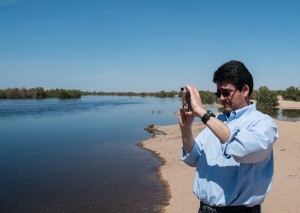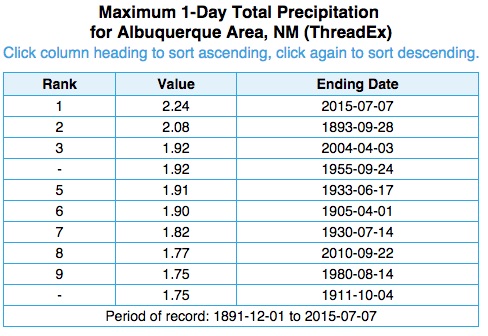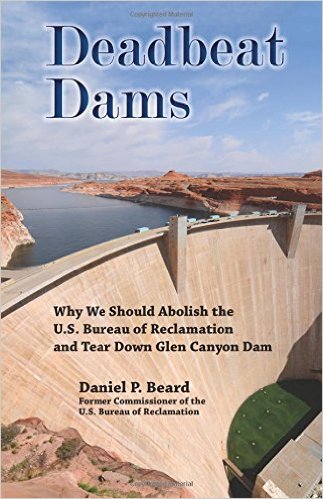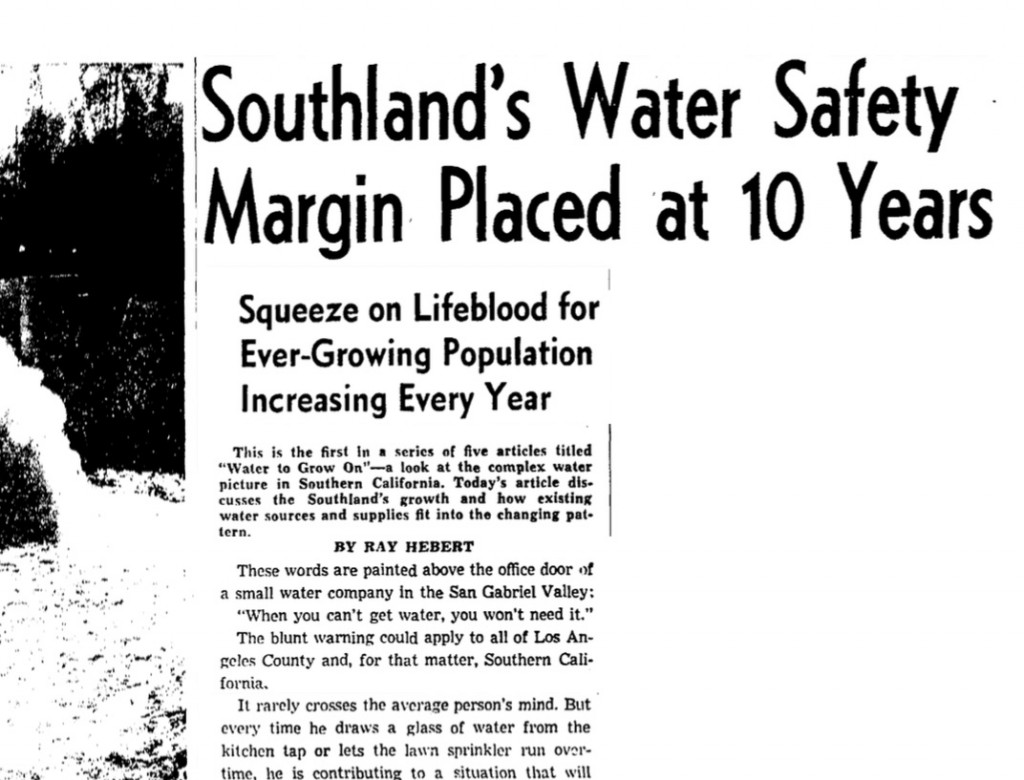That thunderstorm that woke most of us up early this morning (lightning flashes through our skylight at 1:30 a.m.) was one for the record books. At the National Weather Service’s airport gauge (the “official” Albuquerque gauge), 2.24 inches (5.7 cm). According to Brian Guyer at the Weather Service, that’s the single highest 24-hour total in history:
Another example of how drought hits the poor
A recent laboratory test found that water in St. Anthony’s shallow well has twice the concentration of arsenic considered safe.
For many Californians, the state’s long drought has meant small inconveniences such as shorter showers and restrictions on watering lawns. But in two rural valleys, the Coachella southeast of Los Angeles and the San Joaquin to the north, farmworkers and other poor residents are feeling its impact in a far more serious and personal way.
Mike Connor and Dan Beard are wrong about the Bureau of Reclamation and replumbing the West
I’d like to take issue with some recent comments by Dan Beard and Mike Connor, two former commissioners of the U.S. Bureau of Reclamation, about the agency’s future. (Audience sees closeup of Fleck crawling out on tree limb. Camera zooms back to show that it is the only tree for miles around, with no buildings and therefore no chance of rescue. Audience hears sound of sawing.)
Beard
In a weekend New York Times story Beard, who headed the Bureau during the Clinton administration, renews his call for the agency’s elimination:
Daniel P. Beard, a bureau commissioner during the Clinton administration, said the bureau should be abolished, with the authority for water management returned to the states.
“Here we are in the worst drought, climate change is providing a significant impact, and the Obama administration is just studying the problem,” he said. “They should transition to become an environmental agency, and they should just assist local and state agencies to solve water problems in the West.”
It’s an argument Beard lays out in his appropriately titled new book Deadbeat Dams: Why We Should Abolish the U.S. Bureau of Reclamation and Tear Down Glen Canyon Dam. It’s an important book, raising challenging arguments that you need to wrestle with if you’re thinking about water in the western United States. But I disagree with Beard on this central point.
Water scholar and attorney Sarah Bates and Cadillac Desert author Marc Reisner wrestle with this question in Overtapped Oasis: Reform Or Revolution For Western Water, a book that serves as a sort of odd sequel to Cadillac Desert, helpfully clarifying (walking back?) some of Cadillac Desert’s central themes. Their quick laundry list of the problems posed by abolishing the Bureau makes a central point – the Bureau does a bunch of stuff, and if the agency were to be eliminated, someone would still have to do all that stuff:
[I]ts abolition would create a political, administrative, and water-rights nightmare…. Who would then “own” its canals and dams? What about the rights to more than 30 million acre-feet of water it provides? Who would be responsible for dam maintenance? For emergency decisions regarding drought allocations or fish-flow releases?
Bates and Reisner then raise an important political reality that I think undercuts Beard’s argument:
[A]ny attempt to abolish the Bureau of Reclamation would be fanatically resisted by many politicians and organized constituencies in the western states, precipitating a political battle that may not be justified by the results.
This is the “water nobility” about which Beard writes in much detail, and any attempt to abolish the current Bureau structure would, I believe, disproportionately empower this group in the political processes needed to create a replacement structure to do the stuff now done by the Bureau. These folks have really good lobbyists and lawyers.
Connor

Deputy Interior Secretary Mike Connor watches water flow through the normally dry Colorado River bed at San Luis, on the U.S.-Mexico border, March 28 2014, photo by John Fleck
I turn my attention now, gingerly, to the comments of Mike Connor, who was the Obama administration’s first Commissioner of Reclamation, now Deputy Secretary of Interior, and (important disclosure) has generously spent some significant amount of time teaching me about the governance of water in the western United States. (Audience hears sawing of the branch cease, replaced by cracking sound.) In the Times, Connor correctly suggests that the West’s water infrastructure needs a massive rethink:
“We have to think differently,” said Michael Connor, the deputy secretary of the Interior Department, which includes the Bureau of Reclamation. “It’s not enough just to conserve water. We need to rethink these projects. We have a lot of infrastructure, but a lot of it doesn’t work very well anymore. We need to undertake what amounts to a giant replumbing project across the West.”
The way Connor says it supports a central theme of the Times story that I think is wrong: the implication that the Bureau and western water management have been humming along unchanged since the days of Cadillac Desert and have suddenly come to the realization: “Hey, a giant replumbing is needed!”
The whole project of my book challenges that. When I set out to write it some years ago, it was with a post-Cadillac Desert notion that a giant replumbing was needed. What I found again and again, in fact, was that the replumbing has been underway for a while (urban water conservation all over, ag-to-urban transfers galore, re-operation of reservoirs, an environmental flow through the Colorado River Delta for chrissakes). Path dependance and historical contingency make this stuff really hard. People optimized their communities and their lives around the old system. You can’t just kick them off their farms or shut down their city water systems willy nilly. Even if you wanted to (and I think there are important questions of equity and justice that make willy nilly a bad idea), these people fight back, and they’ve got good lawyers. But understanding what replumbing is already underway, what has and has not worked, and what the impediments are as seen through the lens of these replumbing efforts, is the critical piece.
I’m pretty sure Connor would agree with this last bit, the idea that the replumbing is already underway, since’s he’s one of the one of the people who taught me about it.
Let’s just agree to blame the reporter. (Camera zooms back in to see Fleck’s desperate scramble to crawl back before branch breaks.)
Ten years until L.A. runs out of water?
Tijuana: A reminder that *nine* states depend on the Colorado River
There are seven states in the U.S. and two more in Mexico that depend on the Colorado River’s water. Here, from Sandra Dibble, is a reminder that when shortage descends, it is not just Arizona (as I have been guilty of saying) that takes the first hit:
In Mexico, the first impact of cutbacks on the Colorado River — a basin that links seven U.S. states with northern Mexico — is likely to be felt in the sprawling Mexicali Valley in the neighboring state of Sonora, where the smaller San Luis Valley also relies on deliveries of river water and a series of wells fed by seepage of river water.
If there is a shortage declaration in 2017 (as seems likely), Mexico would see a 50,000 acre foot cutback. Sandra’s story is a good primer on the discussions now underway to clarify who will take the hit.
Water policy and the West’s housing market
One of the intellectual frustrations with trying to wrap my head around water policy in the western United States is that it’s really sort of everything policy. There’s climate science and hydrology and history and law and agricultural economics. And, the subject for this afternoon, there’s urban development economics.
Much of the policy struggle has been driven by the explosive growth in sunbelt cities. We started building houses in the 1980s like gangbusters, without a whole lot of thought about how we were going to get enough water to flush their toilets. Here, for example, is single family homes by number of annually issued building permits in Las Vegas:
But then, as you can see, around about 2006 or so we stopped building so many houses. What’s up with that?
Here are the three major metro areas that interest me right now – Albuquerque, Phoenix, and Las Vegas (indexed so that 2001=100 so you can get a feel for the trends in all three, independent of absolute numbers):
My former Albuquerque Journal colleague Richard Metcalf wrote about our situation in this morning’s paper:
The pace of home construction in the Albuquerque metro area has taken a step backward during the first five months of the year, getting off to the second slowest in what is likely decades, according to building permit numbers from DataTraq.
“Population is a huge driver of home construction,” said John Garcia, executive vice president of the HBA, the home builders group in the metro. “We focus on job growth, where we’re at the mercy of business. We need to improve our population growth.”
There’s a rhetoric around this, which you can see in Garcia’s comments, that suggests that many of the region’s economic boosters presume that growth is the norm, and the current situation is not the norm, that we’re gonna somehow “pull out of this slump.”
I’m frustrated that I don’t know enough about the economics of urban development to understand what’s going on here, because the water policy implications of whether this is the new normal, or a slump we’re going to pull out of, are huge. I suspect that if I did understand more urban development economics, I’d simply have a clearer understanding of why we can’t really know what comes next.
What does all this mean as a matter of water policy? Mainly, I guess for now it means that the west’s water policy problems are a lot easier right now, since we’re not building so many new houses. It means that those pie-in-the-sky population growth projections that have driven a lot of the planning and analysis about how much water we have and will need (like the Bureau of Reclamation’s Colorado River Basin Study) are wrong, in a good way. (Yay, our growth-based economies have tanked! We don’t need as much water!)
Public Policy Institute of California water mailing list
The work of Ellen Hanak and her colleagues at the Public Policy Institute of California’s water project is a model for provision of a crucial public good in water policy processes: independent information to help build a shared understanding of the resource and its use.
You can sign up here to get on their mailing list.
On “water wars” rhetoric and policy options
This, by OtPR, on the why the “water wars” “fight or die” rhetoric in the midst of California drought is not only wrong but harmful:
This rhetoric narrows people’s perceived choices, keeps their limbic system activated and postpones mutual solutions. Responsible reporters and editors should stop using it.
I have long thought the various possible roles of journalists maps nicely to Roger Pielke Jr.’s typology of possible roles for scientists in assisting in the policy process. I prefer for myself the role he characterizes in which a scientist engages in “an effort to expand (or at least clarify) the scope of choice for decision-making in a way that allows for the decision-maker to reduce choice based on his or her own preferences and values.” As OtPR correctly observes, “water wars” rhetoric in our work does not expand the range of political and policy choices. It narrows it.
Reclamation funding preliminary Rio Grande basin study work
It’s not a full-on “Basin Study” like the Colorado River got, but the U.S. Bureau of Reclamation today announced $84,000 for preliminary work to define the scope of a Middle Rio Grande (that’s lingo for the New Mexico big) basin study. There’s bigger bucks in the announcement for Salinas and Carmel River Basins in California and the Santa Cruz in Arizona.
These are important bits of institutional infrastructure, providing some dollars and technical muscle in a collaboration with basin stakeholders to improve shared understanding of resources.
Walton on native water rights in the Colorado River Basin
Brett Walton has done us all a great service with a thorough look at the issues surrounding Native American water rights in the Colorado River Basin. Importantly, he’s looking at it not just as a problem, but as an example of what the solution space can look like. The stuff from Kathryn Sorensen, Phoenix’s water manager, is a great example:
Years of careful negotiations, spurred by a desire to avoid long-running court battles, produced legal settlements that provide water for tribes, cities, and industries. Beneficial to all sides, the settlements were a catalyst for urban development and a tool for funding Indian water systems. Perhaps more importantly, the settlements are the foundation of a partnership, an inescapable union, between tribes and their neighbors, a union that will grow in importance as water becomes scarcer in the warming and drying American West.
“We’ve developed tremendous and valuable relationships with each other from being in the same room for years,” Kathryn Sorensen, director of the Phoenix water department, told Circle of Blue. “Water is always important and contentious in Arizona. But having relationships helps you have conversations when you want new solutions.”….
Creative also means selling the temporary right to use water to others, an action called leasing, which is common in the Phoenix metro area. Home to 4.5 million people, Phoenix and its Sonoran Desert neighbors are the biggest beneficiaries of these creative arrangements.
Phoenix leases water from three tribes, and a fourth agreement is nearing completion. The terms of the deals are straightforward. Phoenix makes an upfront payment, typically millions of dollars, to the tribe and pays an annual charge to cover the cost of pumping the water to operators of the Central Arizona Project (CAP) canal, which transports Colorado River water hundreds of miles to the dry heart of the state.
I recommend clicking and reading the entire article.



